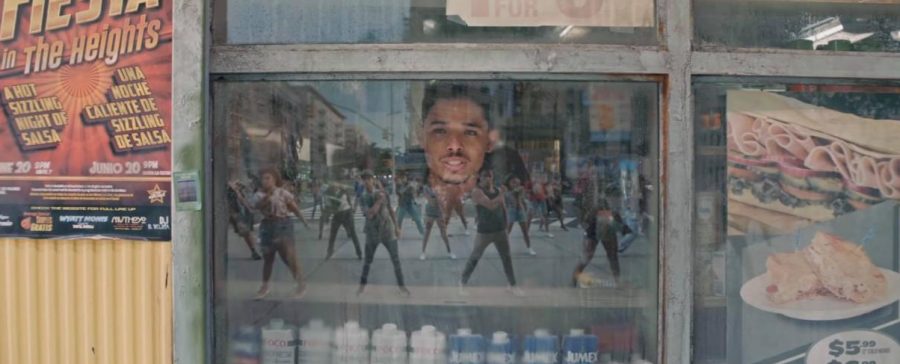‘In the Heights’ Shines Cinematically, Speaks to Representation in Hollywood
Usnavi (Anthony Ramos) looks through his bodega’s window to watch Washington Heights’ residents dancing in the street.(Courtesy HBO Max)
June 14, 2021
A cinematic celebration of Washington Heights and Latin and Hispanic culture, the new movie “In the Heights” is an experience you do not want to miss. This film was directed by Jon M. Chu, known for his directorial work on “Crazy Rich Asians” and “Now You See Me 2,” so it was no surprise that he was able to turn this musical into another film masterpiece.
“In the Heights” is a musical with music by Lin-Manuel Miranda and a script by Quiara Alegría Hudes — its life on the Broadway stage garnered four Tony Awards including “Best Musical.” With the show’s acclaim in conjunction with Miranda’s newfound fame from writing and starring in “Hamilton,” it was a no-brainer that “In The Heights” would be adapted into a multi-million dollar movie.
The Film
The movie follows Usnavi, a young man growing up in Washington Heights and struggling to find a reason to stay in his community after the passing of his parents. He meets Vanessa, a source of inspiration and infatuation, who helps him find reasons to stay.
The film also follows Nina, who has come back home after spending a semester at Stanford, experiencing racism at the school and dropping out. Despite feeling the pressure to be the one who “makes it out” of Washington Heights, she returns to the home she knows and rekindles a connection with Benny, a cab driver who works for her father.
All in all, the show is a heartfelt story of how gentrification negatively affects the business owners and residents who live there and have for generations.
The majority of the dialogue in the film was done through song, which meant that most of the camera work was dedicated to capturing choreography and the feel of Miranda’s music. The cinematography was so calculated and smart, yet fit Christopher Scott’s pedestrian-like choreography and the soundtrack’s orchestrations perfectly.
After the stellar, titular opening number, which played with reflections and wide shots for dynamic choreography, it was difficult to believe that the storytelling could surpass what had just been witnessed. How much grander could the movie get? That question was answered quickly enough during “96,000,” a scene that featured layered animation with a large dance number in a pool.
Another notable scene was “When the Sun Goes Down” where characters Nina and Benny defy gravity and dance on the side of their apartment building, falling in love under the city sunset. Even in all the flashing lights and fireworks that the movie could amplify, the heart of the story was not lost.
The Representation
Chu’s adaptation of this musical lead to such honest representation — not only was this an example of how successful movie musicals can be when legitimately trained Broadway performers are hired but a pinnacle of how important it is to hire and produce work that showcases people of color. The leading actors Anthony Ramos (Usnavi) and Melissa Barrera (Vanessa) both have musical theater backgrounds which were on display during their most tender moments on screen.
While audiences have seen movie musicals whitewashed in the past — “West Side Story” (1961) — diversity in the entertainment industry has been slim to none. Even in 2021, as underrepresented voices are being paid more attention, there remains a lack of representation for people of color in film and television.
According to the University of California, Los Angeles’ 2021 “Hollywood Diversity Report,” only four out of ten leads in film are portrayed by people of color. This statistic not only brings to light the upsetting absence of representation but presumably the unavailability of stories that surround the cultures of people of color.
The ability to see oneself represented in the media can provide inspiration for younger generations and can validate one’s sense of belonging in society. While the leaps and bounds Hollywood has gone through in terms of diversity, it still is not enough. “In the Heights” is a step in the right direction to meeting the need for diversity in the film industry, while being a cinematic joy and feat of talent.
Watch “In the Heights” in theaters or on HBO Max now.








